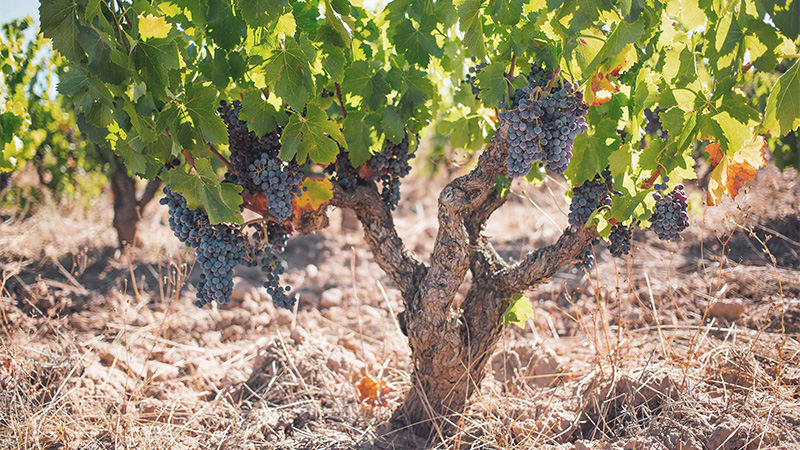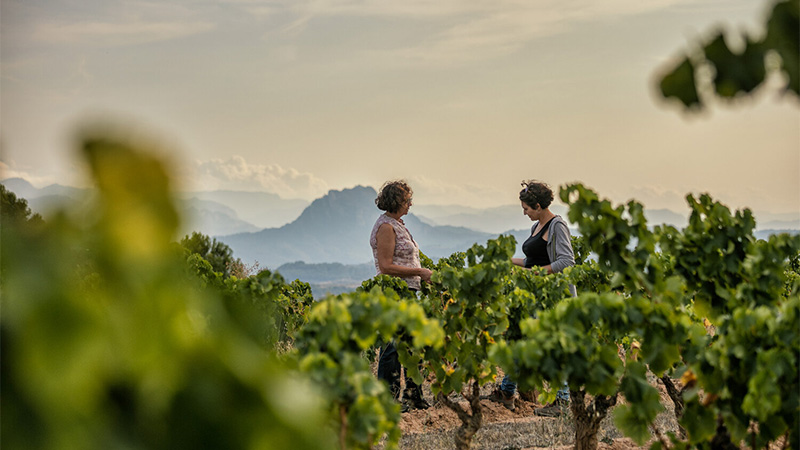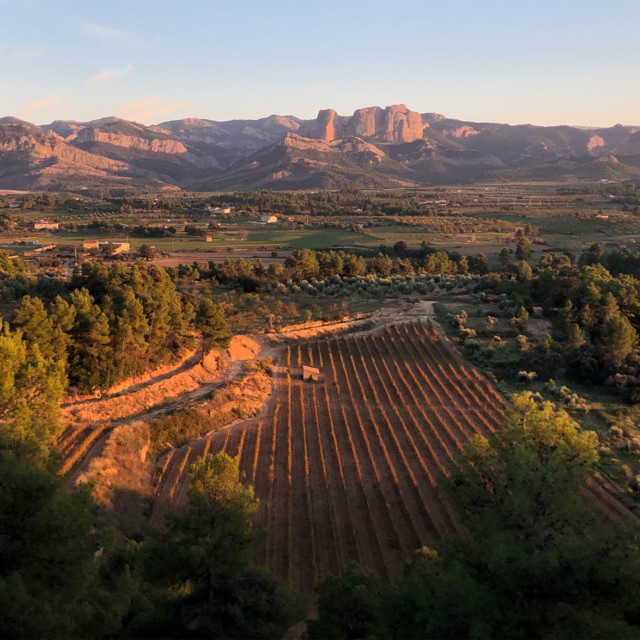One hundred miles from the filament-lit natural wine bars of Barcelona rises Terra Alta, a region few have heard of and even fewer can place on a map. Its name alone, “highlands” in English, conjures images of a magical faraway land. Weathered gothic arches, a once thriving medieval saffron trade, and centuries-long rule by the Templar Knights confer its mystique.
One of Catalonia’s most sparsely populated comarques, or counties, Terra Alta is tenacious, beguiling, and utterly breathtaking. It’s also leading a wine revival turning heads in Berlin, San Francisco, and Tel Aviv.
Located in the extreme southwest corner of Catalonia, Terra Alta is a geographic, cultural, and gastronomic frontier before entering the ancient kingdoms of Aragón, Valencia, and Castile. The Renaissance-era plaza in Horta de Sant Joan, the region’s cultural hub, is testament to a bygone age of dazzling affluence. It’s here where Picasso, inspired by the geometry of the vernacular architecture, created his early Cubist masterpieces more than a century ago.
I recently spoke with rising star in Spanish winemaking Francesc Ferré of Celler Frisach, whose family has lived as farmers outside the village of Corbera d’Ebre for the last 200 years and who is responsible for the region’s thriving natural wine scene. Fran, as he prefers to be called, is a self-proclaimed “wine punk” — but it goes much deeper than that. Pensive and charming, he has a warm smile and towering respect for his land, his ancestors’ hardships, and his belief in forging a brighter future.

“It took two generations to recover from the Civil War,” he says. “Now we’re sowing the seeds — both physically and spiritually — for the next generations.”
Corbera d’Ebre saw some of the heaviest fighting in Spain’s Civil War. The old city was decimated in 1938, its ruins left for all humanity to witness. The Great Freeze of 1956 crippled an already fragile rural society, causing many to pack for the cities; with Franco in power, Republican Spain’s progress across the arts, architecture, and society would be wholly undone.
As for wine, the region revolved around a quantity-over-quality co-op system, leaving little room for experimentation or individual expression. It seemed Terra Alta was heading toward what Sergio Molino coined in his 2016 memoir ”La España Vacía” (“Empty Spain”) — a desolate landscape of ghosts past.
But the opposite happened.
“Most say it was only a question of time,” Pili Sanmartín of Bàrbara Forés Winery tells me as she explains the growing interest in Terra Alta wines. “But it’s more than that. It was a question of believing.”
That belief, following two generations of silence, is today championed by the next generation of winemakers. With advanced degrees and no shortage of courage or conviction, they’re achieving what their grandparents would have thought unimaginable: putting Terra Alta on wine lists across the globe.
The core of Terra Alta’s Denominación de Origen (designation of origin, or D.O.) is the white Grenache, and the region is responsible for one-third of the varietal’s world production at astonishing value.
“It’s completely ours”, Ferré says, referring to the unique set of characteristics he works with. “Forget Instagram. Forget the market. At 1,200 feet, it’s fennel and bay leaf, rosemary and balsamic. It’s the salt of the sea breeze, the mountains. It’s exuberant, subtle, and savage.”
Year after year, Ferré and his brother Joan produce wines with less intervention, less power, and greater finesse.
The folds and crags of Terra Alta’s topography give way to countless microclimates of varying slopes and exposures, linked together by panal, a soil rich with ancient clay sediment deposited from the nearby Ebro River. The result — mature, intense, elegant whites that are harmonious, roasted, and herbal at once.
With every local winemaker I speak with, it is their pride in promoting native grapes — from white Macabeo to reds including Cariñena, Garnacha Peluda, and the more rare gray Grenache and Morenillo — that unites them.
The only county in Catalonia south of the Ebro River, whose fertile plains of citrus and almond rise abruptly to 4,000 feet along Els Ports Massif, Terra Alta sits behind the range at an average 1,500 feet. The region is at a crossroads of Mediterranean and Continental climates, whose scorching summers, cold winters, and proximity to the Mediterranean lend unique conditions for winemaking.
“The wines of Francesc Ferré are a love song to Terra Alta — dynamic, youthful, rural, naked, and happy,” says Joan Roca, head sommelier at Can Roca in Girona, voted multiple times the best restaurant in the world. Despite such praise, Ferré asserts phrases like “trends come and go,” or, “I don’t intervene, I observe, with respect for each year’s harvest and in search of character and origin.”

Ferré’s words remind me of a quotation I love by another Catalan born just 40 miles north: “Originality consists in returning to the origins.” Antoni Gaudí said that.
Ferré relishes in telling me the history of his corner of Terra Alta; his pride in being a farmer first, then winemaker; his metaphor-charged way of describing terroir (Ferré is also a certified oenologue with a degree in environmental engineering). It’s his inherent “punk” attitude that scoffs at the Bordeaux fashions of white button downs and high-profile, outside winemakers.
Six miles down the road from Celler Frisach, Bàrbara Forés Winery is housed in a handsome 19th-century villa in the provincial capital of Gandesa, population 3,000. In addition to championing white Grenache, Pili Sanmartín and her mother Carmen are stewards behind the revival of Morenillo, a native grape to Terra Alta that drinks closer to a Pinot than the bigger red Grenache. Together with a handful of the region’s pioneers — Celler Piñol, Vins del Tros, La Fou and Herencia Altès — Bàrbara Forés was an early advocate of exiting the co-op system in favor of a “truer, more authentic, more honest” expression of their land, Pili Sanmartín says.
The winery’s brisat, a local version of the wildly popular “orange wine” craze sweeping the globe, is in fact a traditional wine of Terra Alta. “There’s nothing orange about it,” Sanmartín proclaims with gusto, explaining how the skins of white Grenache or Macabeo are left in contact with the wine for better preservation, in her case up to six months. The result is a gorgeous, powerful, mature, amber-hued white made in the red style. “It’s the way our ancestors made them,” she says.
Sanmartín’s words reminded me of my first encounter with Ferré, nearly a year ago. We were driving in his pickup when I asked him how he’s able to balance tradition with innovation. “It’s like driving this truck,” he says. “You’ve got a big ol’ windshield in front to see where you’re going. But you’d be silly to not use those small mirrors to see where we’ve been.”
As if his point wasn’t made, Ferré smiles and adds, “and there are lots of beautiful roads in Terra Alta.”
Jon Lerner is originally from New Jersey and has lived in Barcelona for 15 years. He is the founder of Tailored Tours Barcelona, which curates unique gastronomic, cultural, and historical itineraries in and around Barcelona.
